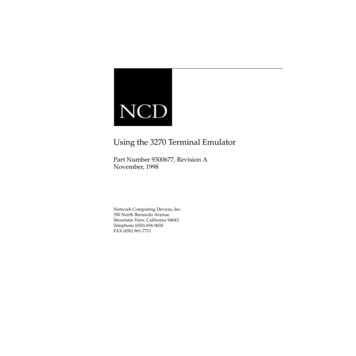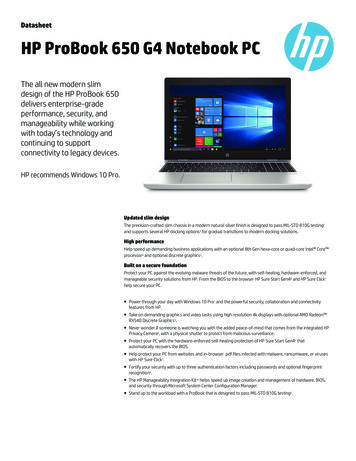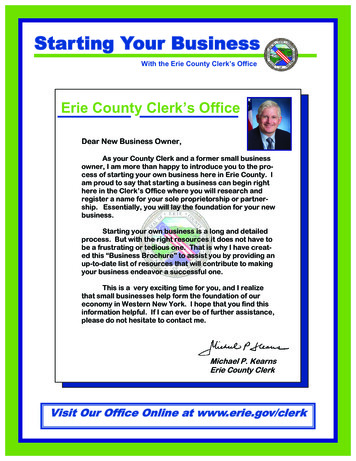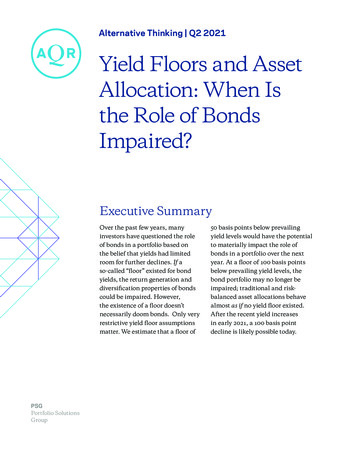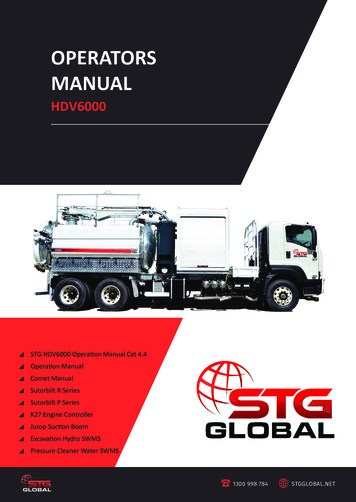
Transcription
A Guide to Starting a CompostingProgram in Your SchoolGreen Mountain Farm to School
This manual was funded through a grant from:Northeast Kingdom Waste Management District31 Church Street, Lyndonville, VT 05851And developed by:Green Mountain Farm to School.194 Main Street, Suite 301, Newport, VT 05855 2010Guide to School Composting2
Table of ContentsWHY COMPOST? 6WHAT IS COMPOSTING? 6THE BENEFITS OF COMPOSTING 6CLOSING THE LOOP: IMPLEMENTING COMPOSTING IN YOUR SCHOOL 7REGULATIONS & HEALTH CONCERNS 8REGULATIONS 8HEALTH AND SAFETY 8GETTING STARTED 10OFF SITE COMPOSTING 13SETTING UP YOUR SYSTEMSUPPLIES AND EQUIPMENTPROCEDURESANNUAL TIME LINEROLES & RESPONSIBILITIESSTAFF AND COMMUNITY CONNECTIONS131315161919ON SITE COMPOSTING 21SETTING UP YOUR SYSTEMSUPPLIES AND EQUIPMENTDAY TO DAY PROCEDURESON-GOING PROCEDURESANNUAL TIME LINEROLES & RESPONSIBILITIESSTAFF AND COMMUNITY CONNECTIONS21212324262930EVALUATION 32APPENDIX I: FAQ ABOUT STARTING A COMPOST AT SCHOOL 35APPENDIX II: SAMPLE FLYER 37APPENDIX III: RECORDING LOGS 41APPENDIX IV: COMPOST SIGNS 45APPENDIX V: COMPOST CONTACTS 55APPENDIX VI: COMPOST BIN DESIGN 59APPENDIX VI: TROUBLE SHOOTING GUIDE 63APPENDIX VIII: RESOURCES 65Guide to School Composting3
Guide to School Composting4
Introduction & GoalsIf your school is like most across the country, recycling has become a part of yourculture. Why not take the next steps and start composting? With one-third of Vermont’sfood scraps being thrown away, composting is a way to promote a responsible andenvironmentally friendly way to deal with waste. Along with saving landfill space, schoolcomposting programs have many benefits:Compost as a finished product enhances the soil and plant quality in schoolvegetable and flower gardensProviding educational opportunities that promote sustainable environmentalpracticesReducing the school’s cost of waste removalProviding a medium for many environmental and science related topics fordiscovery along with opportunities for student development and responsibility,art and inspiration projectsThe goal of this manual is to help aid schools to establish a successful compostingprogram providing information, tips and resources.Guide to School Composting5
Why Compost?What is composting?Nature recycles by breaking down organic material and re-using it. Composting is theaccelerated form of this decomposition process. Inorder for nature to decompose, microorganisms eatand inhabit decaying matter to break these materialsdown even further. Compost happens when materialsare gathered in a bin or pile, moistened, and aerated.Fungi, bacteria, and invertebrates are able to take overand composting happens. In the end, the finishedAll compost ingredients generallyfall under one of two categories,brown or green. Browns are drymaterials such as newspaper, dryleaves, and hay. Greens arefresh, moist materials such asgrass cuttings, manure and foodscraps.product is humus, dark brown organic matter which builds up soil, saves space in thelandfill, and teaches schoolchildren how nature recycles.The Benefits of CompostingThe benefits of composting can be limitless.The amount of trash your school produces is reduced.Nutrients are recycled back into the soil.Soil erosion is prevented when you add compost.Money is saved.Awareness is created around recycling and waste reduction efforts.School pride is raised through the positive contribution made to theenvironment.Guide to School Composting6
Closing the Loop: Implementing Composting in Your SchoolWe can close the loop on the food system by diverting food waste from landfills andturning it back into soil to grow more food.Compost isadded to theschool gardenStudentsgrow food inthe gardenFood scrapsare taken tothe compoststationFood isserved in theschoolcafeteriaStudentsdiscard foodscraps andcompostthemGuide to School Composting7
Regulations & Health ConcernsWhen starting up a composting program at your school people in the community, andpossibly yourself, will have questions about the health and safety of the project.Familiarize yourself with the regulations and safety concerns before you begin.RegulationsSection 5-213 Item 34 of the Health Department’s code for Food safety indicates that―Food waste may be disposed of by composting with the following requirements:A. Compost sites cannot be in close proximity to the outer openings of a foodservice establishment.B. A compost site must be properly operated and kept free of insects, rodents, andvermin.C. Compost sites cannot create a health hazard or nuisance to any foodestablishment or neighboring property owner.‖Health and SafetyComposting can be a fun and educational experience that can involve students, staff,and parents. To make it an educational environment, look into reducing potential risks.1. Protect those likely to be most sensitive. Involve the teachers, school nurse orphysician, parents, and faculty/staff to discover any potentially susceptible studentsor staff. Protect the privacy of medical information, but determine who may haveallergies, be immunocompromised or be prone to infections that could make themsensitive to potential risks. Control exposure of these individuals by restricting whoactually comes in contact with the compost. Other students or the teacher couldfeed the compost bin or take samples. Do not stir or otherwise disturb the pile orbin when people susceptible to inhalation of allergens are nearby.2. If the temperature of the compost pile is properly maintained (it says at a hightemperature), the risk of pathogens is decreased. Be sure to monitor temperaturesand turn the pile frequently. For more information, see the fact sheet on Health &Safey Guidance for Small Scale Composting pdf3. Turning the compost pile will release airborne particles and gases that can causesymptoms in some people. So if a pile is turned, be aware of the wind direction andof the susceptibility of those nearby and those doing the turning. Susceptiblechildren should not turn the compost.Guide to School Composting8
4. Making compost requires a mix of materials, some high in nitrogen (like foodscraps) and others high in carbon (like leaves, newspaper, and hay). Keeping foodscraps covered with high-carbon materials will keep down flies and dispersal offungal spores. Make sure you have a handy source of high-carbon materials. A listof materials and their carbon to nitrogen ratios can be found 5. Practice good hygiene. Anyone coming in contact with the compost bin or compostshould practice good hygiene by either washing hands wellor wearing disposable gloves. Effective hand washingrequires use of soap and sufficient time (sing ―HappyBirthday‖ twice while lathering up). Gloves should beavailable (use of non-latex gloves such as polyethylene isadvisable due to latex allergies) and users should knowproper technique for removing gloves (see diagram). Handsshould be washed after gloves are removed. Anyone withcuts and abrasions should cover them with bandages and wear gloves.Guide to School Composting9
Getting StartedIn six easy steps, here is how to start a composting program in your school:1. Share your ideas and seek out others who may be supportiveInclude as many people as you can to be involved! Ask the principal, food servicestaff, janitor staff, teachers, parents, a knowledgeable compost staff (GMFTS staff),and even students to join in. All of these people need to have a voice in thebeginning stages to help give ownership of the project, insure its sustainability, andprovide a venue for later meetings. Start by having a forum to discuss howcomposting can be done at your school, listen to and express concerns, and learnabout the benefits.2. Recruit a core group of people to develop the idea to form a SteeringCommitteeEffective leadership from a few staff members who are committed to making schoolcomposting a reality is critical to the success of the program. An administrator and afew representatives from other parts of the school community should round out thecommittee. Members can come from the board of education, administration,custodial staff, kitchen staff, teachers and staff, parents and students. Thecommittee is responsible for developing a clear plan of action, promoting theprogram, coordinating the actual work, and evaluating what’s working and what’snot. To start up a program will take several hours of planning. Expect to meet oncea month, at least, for the first year of the process. As the program matures,quarterly meetings may be all that is necessary.3. Research what is involved in a school-wide composting operationNow that you have rallied the support of the school community and formed asteering committee, it is time to look at the compost program infrastructure. Thereare many resources available from organizations to books to websites. This is yourtime to take advantage of others experience to determine the system that will workbest for your school. First, decide if the school will compost on or off site. On sitecomposting comes with both challenges and rewards. Composting can be used as acurriculum resource and the finished product can be used by the school. Challengesrange from the potential issue of odors, rodents and space. Doing the researchahead of time will aid the steering committee in decided on compost bin design,location and supplies.Guide to School Composting10
4. Clearly define the scope of the project (it’s okay to start small)Once you learn as much as you can, the committee will be able to speak about theprocess and clearly plan the scope of the composting program they are envisioning.You can start with a small pilot program or develop the program in phases.5. Follow the school system protocol and garner community supportEach school has different ways they develop new programs. In order for theprogram to be successful, be sure to follow the correct protocols and gather asmuch support and enthusiasm as you go.6. Planning the detailsDon’t forget about the details once you have a plan and a course of action. Makesure everyone knows what to do and why they are doing it! Here are a few tips tohelp in your journey:The convenience is important all down the cafeteria garbage line. Placing a tablenext to where students compost, recycle and throw things away helps studentsmake the right decisions and reduces trash in the compost stream. Anothermethod would be cutting a table to fit three buckets for these three options.Use strong signage to aid the visual connection of separating waste items.Engage student participation throughout the process with artwork like postercontests and stickers (for cafeteria and kitchen). Customized signs are availableat NEKWMD. Posters and signage should visually reflect the specific types ofwaste generated at the school. Customized signs are available at NEKWMD andexamples are located in Appendix II.Creating a strong / fun incentive programs that encourages participation. Yourschool can celebrate a compost awareness week where the students receivetickets for separating compost correctly. During the week, have a drawing at theend of each day for a prize.Save all of your trash for a waste audit! Assess the amount of food wastegenerated to help discover how much of your trash is really compost. Use thewaste audit data to compare to future data either annually or biannually. Also,conducting a waste audit before the official kick off of composting establishes abaseline for comparison. The process will open a discussion with students aboutways to reduce their waste and modify their behaviors. This creates awarenessand starts the conversation about composting.Guide to School Composting11
On-Site vs. Off-Site CompostingChoosing to compost at your school or to send your compost off site is a decision eachschool needs to make early on. What you ultimately decide will be based on space,time and staff.On-Site CompostingOff-Site CompostingThe school maintains composting bins onthe school grounds. All food scraps godirectly into those bins. With dailymonitoring and maintenance, the finishedcompost can be used in the schoolgardens.The school has a local contact that offersto take the cafeteria’s food scraps on aregular basis. The school must arrange apick up time or the transportation of ity todemonstrate a fullcomposting systemto studentsCosts money tobuild a compostingstructureBuilds communityconnectionsSchool keeps thefinished compostedproductCompost pile needsto be maintained ona daily basisLess logistics toSchool does notfigure out (ex:keep finalconstruction of bins) composted productSchool doesn’t needto coordinate daysand times forsomeone to pick upscrapsNeed enough spaceto install a 3-bincompost systemCheaper to startand to continuesince no structuresneed to be builtStorage containersmust be keptoutside until pick upStudents have anactive role in theprocessMust have staff andstudent buy-inNo regular compostpile maintenanceFewer opportunitiesto makeconnections tostudent learningGuide to School CompostingMust coordinatewith someone topick up compost12
Off-Site CompostingSetting Up Your SystemPut out an application for bids for food scrap or organics collection. This caninclude regular haulers, Highfields Composting, community members, or localfarmers. Explain what you are looking for and make sure to ask how often theywill pick up food scraps and how they will use the finished product.Accept an offer and figure out the following details:o When will they pick up and how often? Arranging a consistent schedule,like every day at 2:30, will be easy to remember. Make sure the timeworks for the school and staff.o What is a collection container that they recommend using? Will theyempty the contents during pick up or take the containers with them? Ifthey take them, how and when will they be returned?o Who is responsible for cleaning the collection containers?o Where will the food scraps be picked up? Storage containers kept outsidethe cafeteria doors are typically the most convenient location for bothstoring and collecting food scraps.o What are the do’s or do not’s of their composting program? Some placesallow meat, others do not. Finding out their system up front will allow youfewer problems in the future.Arrange transportation from the school to the composting site if needed.Supplies and EquipmentAll of the parts of the composting process need to be in place before you can startcollecting food scraps during the school day. Make sure to secure the materials youneed to compost at school. You will need:o5 gallon buckets (at least 5 to start with)o1 cart for housing bucketsoCloth ragsoScaleoOutdoor tote (if NEKWMD is picking up)oSawdustoClipboard with record sheetsGuide to School Composting13
5-gallon buckets with lids- as many as necessary to collect food scrapso These will collect food scraps during meal times. The amount you needwill be determined by the number of students, their eating habits, andfrequency of your pick up. If you aren’t sure, start with 5.o After lunch, the buckets will be placed outside in a designated locationwith the lid on. This will prevent odor and pests for a day or two.o If you are part of the Northeast Kingdom Waste Management District,they will provide these buckets at no cost.o Instead of paying for the buckets, find a parent or community memberthat uses 5-gallon buckets and ask them to donate them.1 Cart for housing bucketso A rolling cart to house the buckets can help when transporting them fromthe cafeteria to outside.Cloth ragso Have a supply of rags on hand that are to clean up food scraps frombuckets and floors.Scale that measures in one pound incrementso Recording the weight of food scraps composted everyday can serveseveral purposes. By keeping records, you can show how much food isnot being eaten, how much food is being diverted from the landfill, andhow much waste is produced by the cafeteria over time. Students can getinvolved and use the weights to construct math problems or track thecomposting operation.o The best type of scale to use is one where the weight can be viewed fromthe side or has a memory lock feature since the bin will likely cover thetop of the scale.o You can find a memory lock scale, or industrial scale, by searching onlineor by visiting www.quill.com.Clip board with record sheetso Find an example of a record sheet in Appendix III.Guide to School Composting14
48 gallon toter as an outdoor bino If the waste management district is picking up your food scraps, they willnot collect them everyday. Therefore, a large toter can be used to storethe contents of the 5-gallon buckets.o If you are part of the Northeast Kingdom Waste Management District,they will provide one of these at no cost.Sawdusto If food will not be picked up on a daily basis, placing sawdust on top willprevent odors.o This step is most necessary in warmer months when the risk of odor andattracting animals is present.Procedures1. Place a sign above compost buckets that showstudents what to compost. Some food service staffuse a small white board to write what lunch items canbe composted that each day. Examples of signs canbe seen in Appendix IV.2. Students scrape ALL food scraps into 5 gallon bucketsthat sit on a cart in lunch room.Daily Tasks1. Collect Food Scraps2. Weigh Food3. Transport Food ScrapsOutside4. Clean Up3. Weigh food scraps by placing bucket on a scale and5. Have Food Scrapssubtracting the weight of the container. Record thePicked Upamount to show savings in the disposal of solidwastes produced by the cafeteria. The weights can also be used to constructmath problems or track the composting operation.4. A designated staff or a group of students (one grade can be the compostkeepers) take the buckets with lids outside to the pick up location after everylunch. If using large toters, empty buckets into totes and clean out buckets.5. Buckets should be picked up everyday and large totes should be picked upweekly.6. Adjust your trash pickup schedule accordingly to reflect the diversion of foodscraps and recycling. Be sure to monitor cost change to keep track of themonetary value of composting.Guide to School Composting15
Annual Time LineLaunch Year Time Line Form a Steering Committee Draft a Plan Secure Materials and Supplies Train kitchen staff: develop daily routine, food handling procedures, andcontainer placement Have an all-school assembly with ―Chef Suzette‖ play (Association of VermontRecyclers) to build enthusiasm Offer a small group training for staff, students, and volunteers on cafeteriaprocedures to ensure a smooth transition Have an in-class training with ALL classes about how they will compost duringthe school day Train one of the older grades as Compost Keepers by holding an in-classworkshop that will teach them about monitoring and caring for the compostthroughout the year. Send a note home to parents describing the composting that is going on atschool and the role their children have in it. This is a great way to buildenthusiasm and create a connection to home. An example can be seen inAppendix II. Start Composting- On the first day of composting, make an announcementduring lunch. Have the Compost Keepers stand by the trashcans and compostbuckets to remind students where food and trash goes. Use community volunteers to monitor cafeteria food waste recycling system forapproximately 2 weeks. Thank You Cards- Be sure to properly thank everyone that helped started, caredfor, or provided materials for the compost.Guide to School Composting16
Program Report- Evaluate the effectiveness of your composting infrastructure.Keep track and share the volume of compost collected, the students who helpedand community members involved. Use your program report to challenge yourschool to make a bigger impact next year. Adjust your trash pickup schedule accordingly to reflect the diversion of foodscraps and recycling, monitor cost change.Guide to School Composting17
Second Year and Beyond Time Line Train the next class of Compost Keepers. Hold an in-class workshop that willteach them about monitoring and caring for the compost throughout the year. On the first day of composting, have an All-School Refresher Training. Make anannouncement during lunch to remind students how to use the compost bins.Have the Compost Keepers stand by the trashcans and compost buckets toremind students where food and trash goes. For the next few days, closelywatch the students sorting and train when necessary. Send a note home to parents describing the composting that is going on atschool and the role their children have in it. This is a great way to buildenthusiasm and create a connection to home. Thank You Cards- Be sure to properly thank everyone that helped started, caredfor, or provided materials for the compost. Program Report- Evaluate the effectiveness of your composting infrastructure.Keep track and share the volume of compost collected, the students who helpedand community members involved. Use your program report to challenge yourschool to make a bigger impact next year. Adjust your trash pickup schedule accordingly to reflect the diversion of foodscraps and recycling, monitor cost changeGuide to School Composting18
Roles & ResponsibilitiesIn order to have a successful compost program, the responsibilities need to be clearlydefined and designated. The staff that works with food the most, Food ServiceDirectors, will inevitably have the largest role, but they should not be alone. Don’t beafraid to get the students involved or throw a work party and inviting parents for thelargest tasks.Coordinator: This person will be in charge of making sure all of the tasks areassigned and completed. A Coordinator is the go-to person for any questions orcontacts. (A compost contact form can be found in Appendix V.)Compost Monitor: This person will set up and maintain the compost station inthe kitchen, keep signage and bins in good order, and assure there isappropriate time to sort wastes between lunch periods. The Compost Monitorhas a crucial role of reminding other assigned adults and students when they areto volunteer as the Lunch Sorter.Lunch Sorter: This can be one person or a rotating group that watches theemptying of trays at lunch to ensure that food scraps, recyclables and garbagego into the correct bins.Compost Keeper Class: One class in the school, typically 6h grade or older, isin charge of the compost. After lunch, a few of the students take the food scrapbins to the compost pile. They will take the compost’s temperature, record it,add the food scraps, and top it off with hay. If they notice a temperature drop,damage to the bin, or anything unusual, they will report it to their teacher or thecoordinator.Staff and Community ConnectionsAs you know, there is a wealth of talent and resources in a school building. Make sureeveryone in your school is aware of the program and ask them to share their expertise.TeachersArt teachers can use their classes to help with signage for composting.Science teachers can use the compost for exploration or build on the topic bystarting a worm bin in their classroom.All teachers should encourage students to compost fully, set a proper example atlunch, and be knowledgeable about composting if students have questions.Guide to School Composting19
StudentsOlder students or classes can have leadership roles.Students can plan and be responsible for extra projects that improve thecomposting system.Start a recycling club during the school day or after school.Custodial StaffUse custodial staff as a resource to determine where an appropriate location forplacing food scraps on site would be to maintain curb appeal and functionality.Do they have a role in collecting food scrap buckets? On site how involved arethey in the project?Food Service StaffThe chefs at schools do an amazing job encouraging students to eat good food,use them as a resource to encourage students to compost their food scraps.Encourage food service to compost their kitchen food waste.Ask them to help decide where the best place for compost bucket in kitchen andthe location of outside bin placement.Since food service makes the lunch, they can write the food that is compostabledaily on a white board sign to make it easier for students.Make sure they are comfortable cleaning out the compost buckets as it willundoubtedly fall onto the food service to clean them.ParentsHelp them learn about composting through letters home or their studentsengagement.Ask for parent volunteers to monitor the composting at lunch.Parents can be a great resource for materials, talent and time when starting up aprogram. Find ways to include them.Encourage parents to help enhance the program.Guide to School Composting20
On-Site CompostingSetting Up Your SystemSecure the materials and people you will need to construct your composting bin.We recommend a 3-bin system (plans are in Appendix VI). A compostingsystem should be large enough to handle the demands of your schools foodscraps. It should, therefore, be larger than a home composting bin.Find a local source to provide your school with hay and manure, two things youwill need to help your food scraps turn into compost.Designate a class to be the Compost Keepers. They should empty the foodscraps daily, monitor the piles, and take measurements.Designate a staff member to check on the compost pile, add amendments, turnover piles regularly and add to the garden when needed.Supplies and EquipmentAll of the parts of the composting process need to be in place before you can startcollecting food scraps during the school day. Make sure to secure the materials youneed to compost at school. You will need:o5 gallon buckets(start with at least 5)o1 cart for housingbucketsoScaleoShovel or pitchforkoWork glovesoSupply of hay andmanureoCloth ragsoCompost thermometeroSifting screen5-gallon buckets with lids- as many as necessary to collect food scrapso These will collect food scraps during meal times. The amount you needwill be determined by the number of students, their eating habits, andfrequency of your pick up. If you aren’t sure, start with 5.o After lunch, the buckets will be dumped into the compost pile.o If you are part of the Northeast Kingdom Waste Management District,they will provide these buckets at no cost.o Instead of paying for the buckets, find a parent or community memberthat uses 5-gallon buckets and ask them to donate them.Guide to School Composting21
1 Cart for housing bucketso A rolling cart to house the buckets can help when transporting them fromthe cafeteria to outside.Cloth ragso Have a supply of rags on hand that are to clean up food scraps frombuckets and floors.Scale that measure in one pound incrementso Recording the weight of food scraps composted everyday can serveseveral purposes. Keeping track of the food composted in a period oftime can show savings in the disposal of solid wastes produced by thecafeteria. The total weight of food can also be compared to the amount ofcompost produced. Students can get involved and use the weights toconstruct math problems or track the composting operation.o The best type of scale to use is one where the weight can be viewed fromthe side or has a memory lock feature since the bin will likely cover thetop of the scale.o You can find a memory lock scale, or industrial scale, by searching onlineor by visiting www.quill.com.Shovel, pitchfork or garden fork for turning compost pileWork glovesA steady supply of bulking materials suck as leaves, wood chips, wood shavingsor hay, and manureClip board with record sheetso Find an example of a record sheet in Appendix III.Compost thermometero The long probe of the compost thermometer can take a clear temperaturewhen it is pushed to the center of the pile, where it is warmest.Monitoring the daily temperature of the compost pile will help staff andstudents follow the progress of decomposition. Temperatures can rise to150 degrees, but if temperatures fall and the food scraps have notGuide to School Composting22
decomposed, adjustments need to be made. (See Trouble Shooting Guidein Appendix VII for more information)o You can find a composting thermometer by searching online or by visitingwww.reotemp.com.Sifting screen (hardware cloth stretched over wooden frame)o Sift through the piles to find insects or to see how much food hasdecomposed.o Pieces of non-decomposed food or large scrapes can be sifted from yourfinal product.Daily TasksDay to Day Procedures1. Place a sign above compost buckets that showstudents what to compost. Some food service staffuse a small white board to write what lunch items canbe composted that each day. Examples of signs canbe seen in Appendix IV.1. Collect Food Scraps2. Students scrape ALL food scraps into 5 gallon bucketsthat sit on a cart in the lunch room.4. Take CompostTemperature3. Weigh food scraps by placing a bucket on a scale andsubtracting the weight of the container. Record theamount to sho
best for your school. First, decide if the school will compost on or off site. On site composting comes with both challenges and rewards. Composting can be used as a curriculum resource and the finished product can be used by the school. Challenges range from the potential issue of odors, rodents and space. Doing the research



